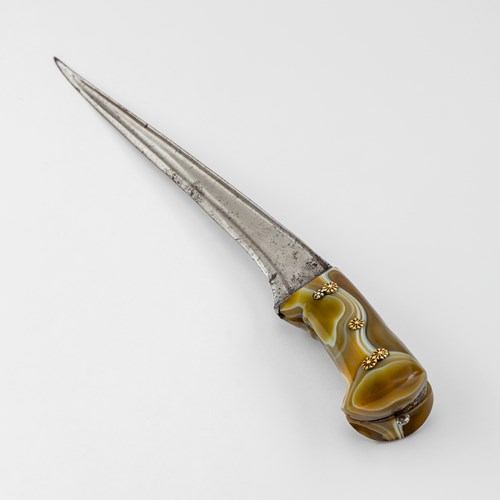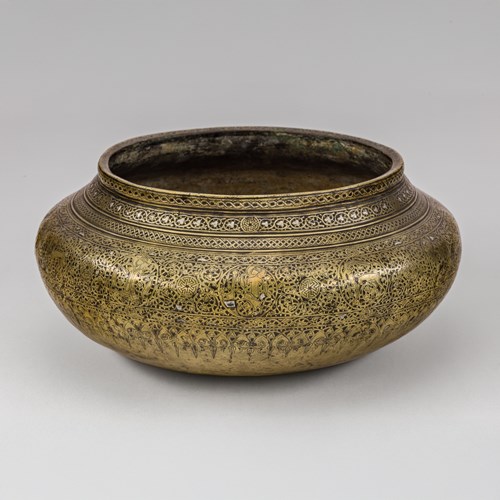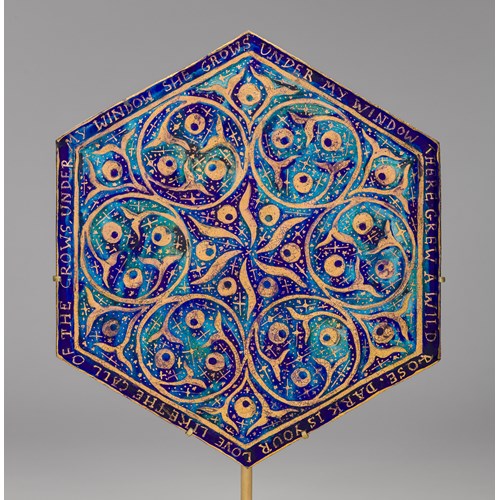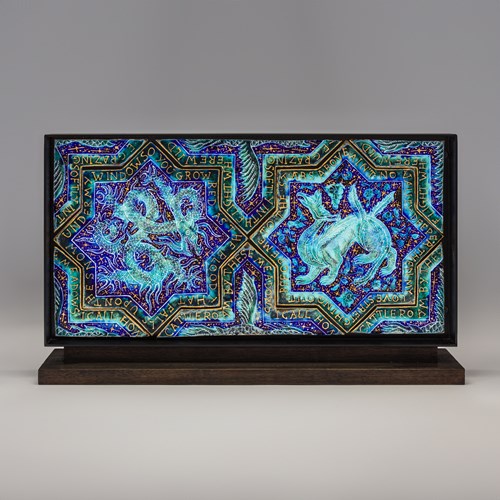Marketplace
Sino-Portuguese Carved Wooden Tray
A rectangular tray with a deep everted border on all four sides, made from carved, lacquered and gilded Chinese camphor wood (Cinnamomum camphora). While the border is carved with a lotus petal frieze, the main panel features a central circular medallion carved with a pelican in her piety and carved quarters of a circle set on the four corners depicting flying doves (the Holy Spirit). The border panels are dovetailed together, while the bottom panel is also dovetailed and pinned to the borders with typical Chinese metal peg-shaped nails.1 Except for the underside, the tray is lacquered in black, with the low-relief carved elements highlighted in gold. Such objects are known in Portuguese as bandejas or tabuleiros. On the first word, the early modern lexicographer Rafael Bluteau (1638-1734) in his Vocabulario Portuguez e Latino (1712-1721) says that these are wooden, round vessels with everted rims within which gifts were sent to friends. As for tabuleiro, which fully corresponds to the present tray, Bluteau explains that this is an oblong vessel with an everted rim used to serve bread and sweets. When raised on a trestle, such trays could also be used as portable tables similarly for serving food. This may be observed from contemporary Namban screens - made in Japan for the local merchant elite - where the Portuguese ship’s captain, sitting on a Chinese folding horseshoe armchair, is being served from a gilded tray set on a low table with cabriole legs - see Museu Nacional de Arte Antiga, Lisbon (inventory no. 1638 Mov).
This particular shape is Chinese in origin and its introduction to Europe dates to the early modern period, via similarly lacquered objects and also smaller versions in porcelain. Usually set on small feet, though sometimes raised on more elaborate stands, the Chinese prototype would serve as a model for similarly-shaped European objects, such as porcelain trays known in French as plateau de déjeuner produced in the 18th century. Its Chinese origin is nonetheless much earlier and was probably first made in precious metal and then copied in less costly materials.2 An oblong rectangular monochrome black lacquered tray with a scalloped everted border, seemingly copying a gold or silver prototype, which was made around 1127-1279 (the late Song dynasty), is today in the National Museum of Asian Art, Washington (inventory no. S1987.364). Similarly-shaped lacquered trays destined for the home market and made in the late Ming dynasty, from the 15th and 16th centuries, are more abundant. A rare late Ming dynasty tray (47.3 cm in length) with indented corners and lacquered in vivid colours highlighted in gold, now in the Victoria and Albert Museum, London (inventory no. Fe.91-1974), has a Tianqi reign mark (r. 1620-1627) and a cylindrical date corresponding to 1624 on the plain black underside.
This tray belongs to a rare group of similarly-shaped objects sharing the same materials and simplified manufacturing techniques typical of Chinese export wares.3 Some of their lacquer coatings have been scientifically analysed and identified as laccol, from the sap of lacquer trees of the species Rhus succedanea, and decorated with gold leaf following Chinese techniques (tiējīnqī, or haku-e in Japanese), and in some instances featuring mother-of-pearl inlays. Not only are the shape and decorative techniques Chinese, but also the thin lacquer coating, since laccol is produced from the sap of lacquer trees native to Vietnam, China and Japan, and was widely used in Chinese lacquers. The presence of these trays has been recorded in late 16th and early 17th-century Portuguese inventories. The most eloquent testimony is given in the inventories of Fernando de Noronha (ca. 1540-1698), 3rd Earl of Linhares and his wife Filipa de Sá (†1618) which record a large number of lacquered and gilded Asian objects.4 Contrary to less reliable contemporary European sources, these exotic commodities are accurately recorded in Portuguese inventories regarding their geographical origin. In the Linhares inventories, a distinction is made between lacquer wares made in the Kingdom of Pegu (in present-day southern Myanmar) and China. Their post-mortem inventories record “four trays from China”, including three with the Linhares coat of arms, all “gilded and black”, and another three, totalling seven lacquered trays.5 The geographical identification of this production has nonetheless continued to puzzle curators, art historians and conservators, even giving rise to unlikely, unsubstantiated hypotheses.6 These include Indian (Cochin or the Gulf of Bengal), Ryukyuan (from the Japanese Ryukyu Islands, then tributary of imperial China), Chinese (Macau) with purported Japanese influence, and even the idea that objects were being carved in one place and lacquered in another. Yet, the scientific analysis and identification of coating materials, decorative techniques and ample archival documentation all point to their South Chinese origin, likely somewhere in the provinces of Guangdong and Fukien.
The most important group of these Chinese carved and lacquered trays belongs to the Museu Nacional de Arte Antiga in Lisbon (inventory nos 1 Band, 2 Band, 3 Band, 26 Band, and 44 Band). Before entering the museum collection, all belonged to women’s religious institutions. The Museu de Aveiro (inventory no. 120/F) holds one large tray (70.5 x 43.0 cm) featuring a double-headed eagle on its central medallion and stylised floral motifs on the corners. Another (68.0 x 43.5 cm), featuring the Augustinian emblem of a heart trespassed by two arrows on the central medallion and stylised animals (lions?) on the corners, belongs to the Museu Nacional Frei Manuel do Cenáculo, Évora (inventory no. ME 1076); on the underside there is an inscription in Chinese characters. Originally from the Convent of Jesus in Aveiro, it lacks most of its lacquered coating. From the same group, decorated with mother-of-pearl, belongs a much smaller tray (38.5 x 22.5 cm) once in the collection of Fernando Távora (1923-2005), in Porto, Portugal; another (67.5 x 44.0 cm) was once in the collection of Luís Pádua Ramos (1931-2005), in Porto; and yet another (65.0 x 41.5 cm) is in the Collection Távora Sequeira Pinto, Porto. Given their shared features, these seem to have been made around the same workshops. The most elaborate of these carved and lacquered trays (68.0 x 34.0 cm) now belongs to the collection of António Horta Osório, Lisbon-London. Unlike the other known trays, it features an exuberant pattern of circles and stylised leaves on both the interior and borders, and is decorated in gold and highlighted with mother-of-pearl inlays.7 More elaborate, and probably made elsewhere in China, mention should be made of a tray (67.8 x 43.8 cm) profusely decorated with mother-of-pearl and not carved like the previous examples.8 It once belonged to the collection of José Lico, Lisbon. It features a courtly love scene on an oval strapwork cartouche copying a contemporary European engraving. Namban examples, made in Japan for export to the European market, albeit much rarer are also known. One such Namban tray (4.1 x 76.5 x 41.0 cm), profusely decorated with mother-of-pearl inlays, is in the Metropolitan Museum of Art, New York (inventory no. 2002.2). Another, partially made from Japanese cypress (Chamaecyparis obtusa) and decorated with mother-of-pearl (62.2 x 36.8 cm), is in the collection of the aforementioned Lisbon museum (inventory no. 20 Band).
One tray in the Lisbon museum (68.0 x 41.0 cm) is identical to the present one, both seemingly made in the same workshop (inventory no. 1 Band). Similarly featuring the lotus-petal frieze central medallion with the pelican in her piety and doves on the corners, the tray in Lisbon lacks most of its original gilding, while the black lacquer coating has become so thin and abraded as to reveal the wood underneath. It originated in the Convent of the Saviour in Lisbon. The pelican in her piety (pie pellicane), an iconography also known as the vulning pelican, depicts a mother pelican cutting into her own flesh to feed her young with her blood. This is symbolic of Jesus Christ shedding his precious blood for the redemption of Humanity, and also a symbol for the Church distributing the graces of Christ’s redemption in the mass and sacraments. It is a symbol of Christian piety and a recurrent motif in early Asian export art made for the Portuguese market. Despite its more evident Christian iconography and its origins within a religious institution, in contrast with the vast majority of the surviving trays, such imagery was nonetheless typical of secular objects made for the highly religious Portuguese elite between the 16th and 17th centuries.
1 On the construction of these trays, see Cancela de Abreu, Pedro. ‘Técnicas de Construção de Objectos Namban’, in Teresa Canepa et al. Depois dos Bárbaros II. Arte Namban para os mercados japonês, português e holandês. London – Lisbon: Jorge Welsh Books, 2008. pp. 59-60.
2 Tahira, Namiko. ‘The Influence of Metal Works on Monochrome Lacquer from the Late Tang Dynasty through the Song Dynasty’, in Chan Kuen On (ed.) Proceedings of Conference on Ancient Chinese Lacquer. Hong Kong: Art Museum, The Chinese University of Hong Kong, 2012. pp. 15-20.
3 On these simplified techniques, see Körber, Ulrike, Schilling, Michael R., Barrocas Dias, Cristina, and Dias, Luís. ‘Simplified Chinese lacquer techniques and Namban style decoration on Luso-Asian objects from the late sixteenth or early seventeenth centuries’, Studies in Conservation 61, Supplement 3 (2016). pp. 68- 84.
4 Crespo, Hugo Miguel. ‘Global Interiors on the Rua Nova in Renaissance Lisbon’, in Annemarie Jordan Gschwend, K. J. P. Lowe (eds) The Global City. On the Streets of Renaissance Lisbon. London: Paul Holberton publishing, 2015, pp. 121-139.
5 Crespo, Hugo. Choices. Lisbon – Paris: AR-PAB, 2015. pp. 238-261, cat. 22, ref. p. 254.
6 Hirokazu, Arakawa. ‘Ryūkyū Lacquerware in Europe - Focusing on the Haku-e technique’, in Kreiner, Josef (ed.) Sources of Ryūkyūan History and Culture in European Collections. Munich: Iudicium Verlag, 1996. pp.197-217; Jordão Felgueiras, José. ‘Mobiliário Indo-Português dos Austrias’, in El Arte en las Cortes de Carlos V y Felipe II. Madrid: Consejo Superior de Investigaciones Científicas, 1999. pp.169-177; de Moura Carvalho, Pedro. ‘Um conjunto de lacas quinhentistas para o Mercado português e a sua atribuição à região de Bengala e costa do Coromandel’ in Pedro de Moura Carvalho (ed.) O Mundo da Laca. 2000 Anos de História (cat.), Lisboa: Fundação Calouste Gulbenkian, 2001, pp.126-153; Dias, Pedro. Mobiliário Indo-Português. Moreira de Cónegos: Imaginalis, 2013, pp. 415-417; and Körber, Ulrike: ‘The “Three Brothers”: Sixteenth-century Lacquered Indo-Muslin Shields or Commodities for Display’, in Annemarie Jordan Gschwend, K. J. P. Lowe (eds), The Global City. On the Streets of Renaissance Lisbon. London: Paul Holberton publishing, 2015. pp. 212-225.
7 Santos Alves, Jorge (ed.) Macau. The First Century of an International Port (exh. cat.) Lisbon: Centro Científico e Cultural de Macau, 2007. pp. 144-145, cat. 38 (entry by Alexandra Curvelo).
8 Canepa, Teresa et al. Depois dos Bárbaros II. Arte Namban para os mercados japonês, português e holandês. London – Lisbon: Jorge Welsh Books, 2008, pp. 336-339, cat. 48 (entry by Teresa Canepa).
This particular shape is Chinese in origin and its introduction to Europe dates to the early modern period, via similarly lacquered objects and also smaller versions in porcelain. Usually set on small feet, though sometimes raised on more elaborate stands, the Chinese prototype would serve as a model for similarly-shaped European objects, such as porcelain trays known in French as plateau de déjeuner produced in the 18th century. Its Chinese origin is nonetheless much earlier and was probably first made in precious metal and then copied in less costly materials.2 An oblong rectangular monochrome black lacquered tray with a scalloped everted border, seemingly copying a gold or silver prototype, which was made around 1127-1279 (the late Song dynasty), is today in the National Museum of Asian Art, Washington (inventory no. S1987.364). Similarly-shaped lacquered trays destined for the home market and made in the late Ming dynasty, from the 15th and 16th centuries, are more abundant. A rare late Ming dynasty tray (47.3 cm in length) with indented corners and lacquered in vivid colours highlighted in gold, now in the Victoria and Albert Museum, London (inventory no. Fe.91-1974), has a Tianqi reign mark (r. 1620-1627) and a cylindrical date corresponding to 1624 on the plain black underside.
This tray belongs to a rare group of similarly-shaped objects sharing the same materials and simplified manufacturing techniques typical of Chinese export wares.3 Some of their lacquer coatings have been scientifically analysed and identified as laccol, from the sap of lacquer trees of the species Rhus succedanea, and decorated with gold leaf following Chinese techniques (tiējīnqī, or haku-e in Japanese), and in some instances featuring mother-of-pearl inlays. Not only are the shape and decorative techniques Chinese, but also the thin lacquer coating, since laccol is produced from the sap of lacquer trees native to Vietnam, China and Japan, and was widely used in Chinese lacquers. The presence of these trays has been recorded in late 16th and early 17th-century Portuguese inventories. The most eloquent testimony is given in the inventories of Fernando de Noronha (ca. 1540-1698), 3rd Earl of Linhares and his wife Filipa de Sá (†1618) which record a large number of lacquered and gilded Asian objects.4 Contrary to less reliable contemporary European sources, these exotic commodities are accurately recorded in Portuguese inventories regarding their geographical origin. In the Linhares inventories, a distinction is made between lacquer wares made in the Kingdom of Pegu (in present-day southern Myanmar) and China. Their post-mortem inventories record “four trays from China”, including three with the Linhares coat of arms, all “gilded and black”, and another three, totalling seven lacquered trays.5 The geographical identification of this production has nonetheless continued to puzzle curators, art historians and conservators, even giving rise to unlikely, unsubstantiated hypotheses.6 These include Indian (Cochin or the Gulf of Bengal), Ryukyuan (from the Japanese Ryukyu Islands, then tributary of imperial China), Chinese (Macau) with purported Japanese influence, and even the idea that objects were being carved in one place and lacquered in another. Yet, the scientific analysis and identification of coating materials, decorative techniques and ample archival documentation all point to their South Chinese origin, likely somewhere in the provinces of Guangdong and Fukien.
The most important group of these Chinese carved and lacquered trays belongs to the Museu Nacional de Arte Antiga in Lisbon (inventory nos 1 Band, 2 Band, 3 Band, 26 Band, and 44 Band). Before entering the museum collection, all belonged to women’s religious institutions. The Museu de Aveiro (inventory no. 120/F) holds one large tray (70.5 x 43.0 cm) featuring a double-headed eagle on its central medallion and stylised floral motifs on the corners. Another (68.0 x 43.5 cm), featuring the Augustinian emblem of a heart trespassed by two arrows on the central medallion and stylised animals (lions?) on the corners, belongs to the Museu Nacional Frei Manuel do Cenáculo, Évora (inventory no. ME 1076); on the underside there is an inscription in Chinese characters. Originally from the Convent of Jesus in Aveiro, it lacks most of its lacquered coating. From the same group, decorated with mother-of-pearl, belongs a much smaller tray (38.5 x 22.5 cm) once in the collection of Fernando Távora (1923-2005), in Porto, Portugal; another (67.5 x 44.0 cm) was once in the collection of Luís Pádua Ramos (1931-2005), in Porto; and yet another (65.0 x 41.5 cm) is in the Collection Távora Sequeira Pinto, Porto. Given their shared features, these seem to have been made around the same workshops. The most elaborate of these carved and lacquered trays (68.0 x 34.0 cm) now belongs to the collection of António Horta Osório, Lisbon-London. Unlike the other known trays, it features an exuberant pattern of circles and stylised leaves on both the interior and borders, and is decorated in gold and highlighted with mother-of-pearl inlays.7 More elaborate, and probably made elsewhere in China, mention should be made of a tray (67.8 x 43.8 cm) profusely decorated with mother-of-pearl and not carved like the previous examples.8 It once belonged to the collection of José Lico, Lisbon. It features a courtly love scene on an oval strapwork cartouche copying a contemporary European engraving. Namban examples, made in Japan for export to the European market, albeit much rarer are also known. One such Namban tray (4.1 x 76.5 x 41.0 cm), profusely decorated with mother-of-pearl inlays, is in the Metropolitan Museum of Art, New York (inventory no. 2002.2). Another, partially made from Japanese cypress (Chamaecyparis obtusa) and decorated with mother-of-pearl (62.2 x 36.8 cm), is in the collection of the aforementioned Lisbon museum (inventory no. 20 Band).
One tray in the Lisbon museum (68.0 x 41.0 cm) is identical to the present one, both seemingly made in the same workshop (inventory no. 1 Band). Similarly featuring the lotus-petal frieze central medallion with the pelican in her piety and doves on the corners, the tray in Lisbon lacks most of its original gilding, while the black lacquer coating has become so thin and abraded as to reveal the wood underneath. It originated in the Convent of the Saviour in Lisbon. The pelican in her piety (pie pellicane), an iconography also known as the vulning pelican, depicts a mother pelican cutting into her own flesh to feed her young with her blood. This is symbolic of Jesus Christ shedding his precious blood for the redemption of Humanity, and also a symbol for the Church distributing the graces of Christ’s redemption in the mass and sacraments. It is a symbol of Christian piety and a recurrent motif in early Asian export art made for the Portuguese market. Despite its more evident Christian iconography and its origins within a religious institution, in contrast with the vast majority of the surviving trays, such imagery was nonetheless typical of secular objects made for the highly religious Portuguese elite between the 16th and 17th centuries.
1 On the construction of these trays, see Cancela de Abreu, Pedro. ‘Técnicas de Construção de Objectos Namban’, in Teresa Canepa et al. Depois dos Bárbaros II. Arte Namban para os mercados japonês, português e holandês. London – Lisbon: Jorge Welsh Books, 2008. pp. 59-60.
2 Tahira, Namiko. ‘The Influence of Metal Works on Monochrome Lacquer from the Late Tang Dynasty through the Song Dynasty’, in Chan Kuen On (ed.) Proceedings of Conference on Ancient Chinese Lacquer. Hong Kong: Art Museum, The Chinese University of Hong Kong, 2012. pp. 15-20.
3 On these simplified techniques, see Körber, Ulrike, Schilling, Michael R., Barrocas Dias, Cristina, and Dias, Luís. ‘Simplified Chinese lacquer techniques and Namban style decoration on Luso-Asian objects from the late sixteenth or early seventeenth centuries’, Studies in Conservation 61, Supplement 3 (2016). pp. 68- 84.
4 Crespo, Hugo Miguel. ‘Global Interiors on the Rua Nova in Renaissance Lisbon’, in Annemarie Jordan Gschwend, K. J. P. Lowe (eds) The Global City. On the Streets of Renaissance Lisbon. London: Paul Holberton publishing, 2015, pp. 121-139.
5 Crespo, Hugo. Choices. Lisbon – Paris: AR-PAB, 2015. pp. 238-261, cat. 22, ref. p. 254.
6 Hirokazu, Arakawa. ‘Ryūkyū Lacquerware in Europe - Focusing on the Haku-e technique’, in Kreiner, Josef (ed.) Sources of Ryūkyūan History and Culture in European Collections. Munich: Iudicium Verlag, 1996. pp.197-217; Jordão Felgueiras, José. ‘Mobiliário Indo-Português dos Austrias’, in El Arte en las Cortes de Carlos V y Felipe II. Madrid: Consejo Superior de Investigaciones Científicas, 1999. pp.169-177; de Moura Carvalho, Pedro. ‘Um conjunto de lacas quinhentistas para o Mercado português e a sua atribuição à região de Bengala e costa do Coromandel’ in Pedro de Moura Carvalho (ed.) O Mundo da Laca. 2000 Anos de História (cat.), Lisboa: Fundação Calouste Gulbenkian, 2001, pp.126-153; Dias, Pedro. Mobiliário Indo-Português. Moreira de Cónegos: Imaginalis, 2013, pp. 415-417; and Körber, Ulrike: ‘The “Three Brothers”: Sixteenth-century Lacquered Indo-Muslin Shields or Commodities for Display’, in Annemarie Jordan Gschwend, K. J. P. Lowe (eds), The Global City. On the Streets of Renaissance Lisbon. London: Paul Holberton publishing, 2015. pp. 212-225.
7 Santos Alves, Jorge (ed.) Macau. The First Century of an International Port (exh. cat.) Lisbon: Centro Científico e Cultural de Macau, 2007. pp. 144-145, cat. 38 (entry by Alexandra Curvelo).
8 Canepa, Teresa et al. Depois dos Bárbaros II. Arte Namban para os mercados japonês, português e holandês. London – Lisbon: Jorge Welsh Books, 2008, pp. 336-339, cat. 48 (entry by Teresa Canepa).
Plus d'œuvres d'art de la Galerie









